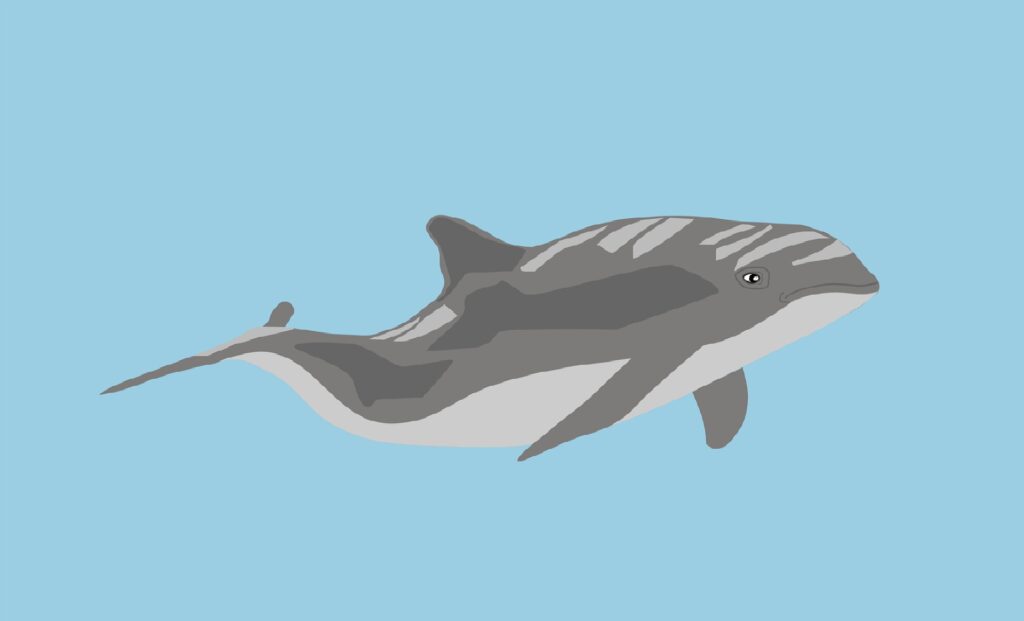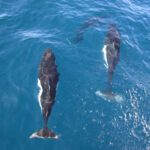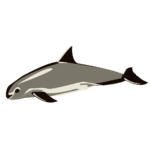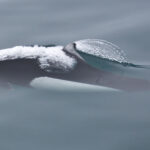Porpoises are amazing marine mammals that live in oceans and seas worldwide. They’re part of the Phocoenidae family, related to dolphins and whales. Porpoises are known for their sleek bodies, intelligence, and playful behavior.
Their diet is an important factor in their survival. Porpoises mainly eat fish like herring, cod, mackerel, and anchovies. They have sharp teeth and use echolocation to find food underwater. They prefer coastal waters with abundant fish populations, but they can also go to deeper offshore areas. They’re opportunistic hunters, adjusting their diet depending on what’s available in their habitat.
Porpoises also feed on cephalopods like squid. This flexibility helps them cope with changes in their environment.
The diet of porpoises varies by species and location. For example, harbor porpoises mainly eat small schooling fish found in estuaries and coastal waters. Dall’s porpoise has been seen eating various types of fish and squid.
Researchers can use this knowledge to better understand porpoises’ role in marine ecosystems. It emphasizes the importance of conservation to ensure their continued survival. A fun fact about porpoises – don’t get in their way during mealtime!
Key Takeaways
- Porpoises primarily eat fish and squid.
- They have a varied diet depending on their habitat and availability of prey.
- Porpoises are skilled hunters and use echolocation to locate their prey.
- They have sharp teeth that help them catch and consume their food.
- Some porpoise species also feed on crustaceans and small marine invertebrates.
- The diet of porpoises is essential for their survival and overall health.
The Importance of Understanding Porpoise Diet

Understanding porpoise diet is key to their health and survival. These fish-eaters mainly chow down on herring, mackerel, and cod. Studying their meals helps us understand how many fish are in different areas. Knowing what porpoises eat also helps us spot potential threats to them.
To protect these creatures, we must manage fishing responsibly. This means setting stricter regulations to protect their food sources. We must also reduce marine pollution so that toxins don’t get into their food.
Understanding porpoise diet is essential for conserving them. It helps us protect our oceans and make sure porpoises are around for future generations. Let us strive for a world where they can keep playing in the seas!
Factors Influencing Porpoise Diet
Factors that influence porpoise diet vary due to external and internal factors. To study their behaviour and aid conservation, understanding what affects their feeding is key. Let’s explore factors in a descriptive table:
| Factors | Description |
|---|---|
| Geographic Location | Porpoises in different regions have different food sources. |
| Available Prey | Prey abundance and availability are big diet influencers. |
| Life Stage | Younger porpoises and adults may have different dietary needs. |
| Seasonal Variations | Seasons affect prey availability, thus affecting diet. |
This insight gives researchers and conservationists data to better protect these mammals. A pro tip: continuous monitoring of prey populations can provide data on porpoise dietary preferences, aiding conservation. Porpoises love fish so much, they could be swimming stomachs with fins!
Common Types of Prey for Porpoises
Porpoises are amazing animals that rely on a range of prey for their survival. From little fish to crustaceans, they have a varied diet that lets them thrive in different marine habitats.
Let’s take a look at the types of prey porpoises feed on:
| Prey | Description | Habitat |
|---|---|---|
| Herring | Silvery fish with a lateral line. Found in both shallow and deep waters. | Coastal areas, open oceans |
| Anchovies | Small schooling fish, silver in color. An essential part of the marine food chain. | Coastal areas, open oceans |
| Squid | Soft-bodied cephalopods with tentacles. Equipped with suckers for capturing prey. | Oceans, deep waters |
| Shrimp | Slender crustaceans with long antennae. Often near the ocean floor. | Coastal areas, estuaries |
In addition to these common preys, porpoises also eat mackerel and smelt. They use echolocation to hunt, emitting high-frequency sounds to find food underwater.
To sustain porpoise populations, it’s essential to protect their habitats from pollution and overfishing. Creating marine protected areas helps keep food sources safe, and provides a habitat for reproduction.
We can help reduce accidental bycatch of porpoises by promoting responsible fishing practices. Such as using nets with larger mesh sizes, and avoiding fishing in critical feeding grounds during sensitive seasons.
Preserving coastal ecosystems is also important since many prey species rely on healthy coastal habitats for breeding and feeding. Conservation efforts should focus on reducing pollution, controlling invasive species, and promoting sustainable fisheries management.
It’s time for porpoises to show off their hunting and feeding skills!
Hunting and Feeding Mechanisms of Porpoises

Porpoises have unique hunting and feeding mechanisms. Echolocation is one of their abilities, which allows them to navigate and hunt by emitting high-frequency clicks. Through this, they can detect objects and locate prey.
Porpoises also pursue fast-swimming fish species with agility and speed. They swallow their prey whole without chewing, thanks to their expandable throats. These intelligent creatures even work together in groups for cooperative hunting.
Selective feeding is another interesting trait of porpoises. Depending on where they live, they exhibit particular preferences for certain types of prey. This helps them survive in various marine habitats.
MarineBio conducted a study which showed that porpoises can consume up to 10% of their body weight in fish each day. This impressive feat reveals their hunting efficiency.
These amazing hunting and feeding mechanisms show the intricate design of nature, and the incredible diversity of marine ecosystems. Porpoises have it all figured out!
Seasonal Variations in Porpoise Diet
Seasonal variations are essential for porpoise diets. Let’s take a closer look at these marine creatures’ feeding habits.
The table below outlines prey species and their prevalence throughout different seasons.
| Seasons | Prey Species | Prevalence |
|---|---|---|
| Spring | Herring | High |
| Mackerel | Medium | |
| Sand eels | Low | |
| Summer | Squid | High |
| Anchovies | Medium | |
| Sole | Low | |
| Autumn | Sprat | High |
| Cod | Medium | |
| Sardines | Low |
Porpoises consume herring, mackerel, and sand eels more during spring. Summer brings squid, anchovies, and sole. In autumn, sprat, cod, and sardines become more common.
These dietary shifts are due to the behavior and migration of prey species. Porpoises adapt to these changes by adjusting their diet accordingly.
Conservationists and researchers can use this info to protect our oceans. Human actions have affected porpoise diet and our ability to make a funny joke about it.
Impact of Human Activities on Porpoise Diet

Human activities have a big impact on porpoises’ diets. They change their natural food sources and make them adjust to different ones. This change of diet can have all kinds of results for these marine creatures.
Let’s look at it more carefully:
Impact of Human Activities on Porpoise Diet
- Commercial fishing: Reduces the availability of their favorite prey.
- Pollution: Contaminated food harms them.
- Noise pollution: Interferes with their foraging, leading to less food.
It’s important to remember that human activities don’t only decrease their preferred food, but also bring pollutants. These pollutants build up in their food, which can affect their health.
Here’s a tip: If we use sustainable fishing and reduce pollution, we can protect porpoises and their diet without as much human interference. Trying to manage a porpoise’s diet is hard!
Conservation and Management of Porpoise Diet
Porpoises have diverse dietary preferences. They mainly eat cod, hake, sardines, squid, shrimp, and other marine creatures. Their sharp teeth help them hunt swiftly and effectively.
The table below shows the Conservation and Management of Porpoise Diet:
| Species | Diet | Quantity | Prey |
|---|---|---|---|
| Species A | Harbor Porpoise | 5-10 kg/day | Fish, Squid, Shrimp |
| Species B | Dall’s Porpoise | 6-12 kg/day | Fish, Krill, Squid |
| Species C | Burmeister’s Porpoise | 3-7 kg/day | Small Fish, Squid, Octopus |
Conservation efforts to manage porpoise diet have helped mitigate threats from overfishing. Organizations have implemented measures to protect key prey species and ensure a healthy food chain. This has sustained porpoise populations worldwide.
Preserving porpoise diets is vital for their survival. After all, nobody wants hungry dolphins taking over the ocean!
Frequently Asked Questions
FAQ 1: What do porpoises eat?
Porpoises primarily eat small fish, such as herring, capelin, and sand lance. They may also consume squid and shrimp.
FAQ 2: How do porpoises hunt for their food?
Porpoises are skilled predators and use their echolocation abilities to locate and track their prey. They emit high-frequency clicks that bounce off objects in the water, helping them determine the location, size, and shape of their food.
FAQ 3: Do porpoises eat plants or seaweed?
No, porpoises are carnivorous animals that feed exclusively on marine animals. They do not consume plants, seaweed, or any other vegetation.
FAQ 4: Are there any specific feeding habits of porpoises?
Porpoises are opportunistic feeders and will adapt their diet based on the availability of prey in their habitat. They tend to feed on small schooling fish that are abundant in their environment.
FAQ 5: Do porpoises eat other marine mammals?
No, porpoises do not typically prey on other marine mammals. They primarily focus on consuming smaller fish and invertebrates rather than larger animals.
FAQ 6: How much do porpoises eat in a day?
The exact food consumption of porpoises varies depending on species, size, and natural conditions. On average, porpoises consume approximately 10-15% of their body weight in food daily.
Conclusion
Preserving porpoise diet is key for their survival. These mammals need specific types of food to stay healthy in their habitats. Their preferred diet affects their population and the whole ecosystem.
We need to realize the connection between porpoises and their food sources. They eat a variety of marine organisms, such as fish, squid, and crustaceans. Each one is important to their nutrition, energy, growth, reproduction, and immune system.
Porpoises have choices about what they eat. Scientists have seen that the size, availability, and location of prey influences their decisions. If we save the populations of their preferred species, porpoises will have food.
An imbalanced diet can be bad for porpoises. If certain prey species become scarce, porpoises may have to switch to food with less nutrition. This can cause malnutrition, low reproduction, and a decline in population.
We can do things to help.
- Regulations must prevent overfishing and maintain sustainable practices in porpoise habitats.
- Also, protected areas can let key prey species live without being disturbed.
We should also inform people about the need to preserve porpoise diets. We can get fishermen and others involved in conservation efforts. This can lead to more responsible fishing that takes into account porpoises’ needs.
References




